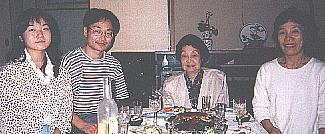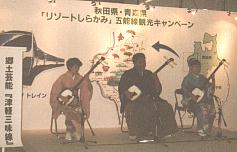| The Japan Rail Pass is one of the better travel deals to be had: unlimited travel on what is arguably the best infrastructure system in the world. And you thought there weren't any bargains in Japan! |
Reno-mania: Japanese Construction
As I walked from the station to Obaasan's house, I nearly got lost. Over the years, I have noticed a gradual improvement in the houses and the cars in the driveways, reflecting Japan's rise as an economic superpower. On this trip, the neighbourhood was almost unrecognizable. Apparently some Japanese tax law serves as a very strong incentive to spend money renovating or rebuilding houses. Obaasan had had some construction done, too. She showed me step-by-step photos of how two small apartment buildings had been built on part of her property.
Shinjinrui ("The New Breed")
 My cousin Mayumi (left) was visiting that day. She's hatachi now
(
20 years old, the age of
adulthood in Japan) and attending a nearby college.
Yoneko Obasan (right), who looks after
Obaasan (middle),
thinks Mayumi's a nice girl, but different. "They're all different, these
young people. I can't understand them." I didn't get to interact with Mai-chan
enough to form my own opinion -- she kept excusing herself from the table to
talk on her handyphone.
My cousin Mayumi (left) was visiting that day. She's hatachi now
(
20 years old, the age of
adulthood in Japan) and attending a nearby college.
Yoneko Obasan (right), who looks after
Obaasan (middle),
thinks Mayumi's a nice girl, but different. "They're all different, these
young people. I can't understand them." I didn't get to interact with Mai-chan
enough to form my own opinion -- she kept excusing herself from the table to
talk on her handyphone.
| Handyphones (PHS) have been a must-have accessory for any young woman (and anyone) in Japan for the last couple of years. They're inexpensive and compact -- if a sarariman is walking down the street looking like he's talking into his shirt cuff, he probably has a handyphone in there somewhere. |
I slept in the same room where we ate. In Japan houses are small, so guest rooms are out of the question. Any way, "Have futon, will sleep ... anywhere." To make space, I propped the table on its side next to the stereo. Hisao Ojisan, my mother's eldest brother, checked in on me before turning in for the night, saw the table and quickly moved it over to the far wall. "What if there's an earthquake?" he said. Hmm, I guess I'm not really trained to think of that -- unlike Japan, there aren't too many tremors in rock-solid Canada. :p
Akihabara - "Electronics Town"
When I'm in Tokyo, I usually make a trip to Akihabara, the electronics district. With the rise of the yen, it's not so much a place to find deals anymore as the place to see new gadgets when they first appear. Obaasan always calls Akihabara "Akibahara". I thought this was just a cute quirk of hers, like a certain former pathology assistant's habit of saying "larnyx", instead of "larynx". I have since learned about the history of Akihabara on the Internet and found out she's been right all along!
Shinjuku
 Another regular stop for me is
Shinjuku. As I got off the commuter train, I heard a sound that was
familiar but out of context. There was a
shamisen concert in the
middle of one of the busiest train stations in Tokyo! Many people stopped to watch
the show, which was to promote the start of a new service to northern Japan.
They looked like they should have been hurrying off to work, but they stayed
at length to listen -- I guess hearing shamisen music must have been unusual
for them these days, too.
Another regular stop for me is
Shinjuku. As I got off the commuter train, I heard a sound that was
familiar but out of context. There was a
shamisen concert in the
middle of one of the busiest train stations in Tokyo! Many people stopped to watch
the show, which was to promote the start of a new service to northern Japan.
They looked like they should have been hurrying off to work, but they stayed
at length to listen -- I guess hearing shamisen music must have been unusual
for them these days, too.
| Because of an emphasis on Western music since the Meiji Era (late 1800s), few Japanese today are familiar with traditional instruments. Schools are planning a new music program so that children can know their musical roots. |
 Outside the station it was Shinjuku: Situation Normal.
Youth fashion was on parade, displaying all the current styles: bleached brown hair,
loose socks,
Casio
Baby-G watches, handy phones, black Prada backpacks. And cigarettes:
like Canada, smoking is on the rise among young women.
Outside the station it was Shinjuku: Situation Normal.
Youth fashion was on parade, displaying all the current styles: bleached brown hair,
loose socks,
Casio
Baby-G watches, handy phones, black Prada backpacks. And cigarettes:
like Canada, smoking is on the rise among young women.
One of the landmarks in Shinjuku
is Studio Alta, a store with a giant television screen on the outside.
Everybody knows where Alta is, so it is a convenient place to meet.
Unfortunately, everybody thinks the same way (this is Japan after all),
so spotting your party in the huge throng is problematic. And if it rains (as it did this day, what with Typhoon #20
on its way), you have to peer under all the umbrellas!
| Accurately targeting products for the young female market is apparently the key to business success in Japan. |
A Changing Shopping Scene?
All of the major Japanese depaato (DEPAATOmento sutoah = department store) chains have a presence in Shinjuku. Browsing around, I wondered if I was detecting a slight drop in the level of customer service: not everybody says, "Irasshaimase!", the bowing escalator girls are gone, as are most of the chirping elevator girls, and items bought are sometimes only gift wrapped upon request. It's still royal treatment by Canadian standards, though. Other than this, I could see very little evidence of the fukeiki (recession) that has affected Japan over the past few years.
Indian Restaurant in Japan
Not only does Shinjuku have many stores, there are lots of restaurants serving cuisine from around the world. I went to an Indian restaurant with Naoko, who studied English in Toronto earlier this year. She hopes to work for the United Nations in undeveloped countries some day. Her outward vision reflects Japan's push in recent years towards "internationalization". The waiters were from South Asia and spoke better Japanese than me. I wondered what kind of life they were living in Tokyo. The curries were excellent, however the rice pilau was made with gohan (Japanese short-grained rice), not long-grained basmati rice!
|
Local Food
Can there be one in cosmopolitan Tokyo? |
